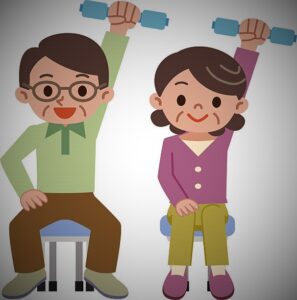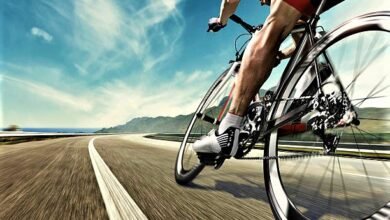low impact anaerobic exercise

low impact anaerobic exercise
Aerobic and anaerobic exercise
Aerobic exercise or aerobic exercise

This is a form of exercise where the muscles rely on oxygen and glucose as their primary source of energy to produce the energy they need, the body requires large amounts of oxygen to convert fats, carbohydrates and proteins into fuel for energy, so cells often deplete energy from aerobic metabolism, such as, At rest, during aerobic exercise and in the body adequately. When oxygen and nutrients are available, the cells of the body run through a metabolism process in which food produces energy by reacting with oxygen. required by the body.
The intensity of these exercises does not exceed muscle resistance and does not reach the stage of tension. The intensity of these exercises ranges from low to high intensity.
Endurance is defined as a person’s ability to perform a movement over and over again without getting tired. Resistance exercises aim to improve the ability to resist fatigue and the ability to work for a long time without reducing the degree of efficiency or effectiveness.
Important note: If the intensity of the exercise increases, it may be necessary to reduce the duration and frequency of the exercise. Likewise, if the frequency or duration increases, it may be necessary to reduce the intensity.
Aerobic and anaerobic exercises differ from each other, as their names indicate the presence or absence of air and its entry into the metabolism process that produces energy for the muscles.
Aerobic exercises can turn into anaerobic exercises if they are performed at a very high intensity. These exercises can be simple, practical, and realistic. Some machines can be used to perform these exercises, but they are not always necessary. For example, walking, light jogging, long-distance running, running on a treadmill, dancing, long-distance swimming, an exercise bike, stationary rowing, long-distance rowing, skipping rope at easy altitude. Or any exercise that raises your heart rate about 10 minutes after the start of the activity, and this type of exercise is done for a relatively long time.
Benefits of aerobic exercise:

Low intensity.
Normal and average.
It includes large muscles, the main of which are the muscles of the lower extremities.
No speed, violence or heavy loads
Benefits of aerobic exercise:
The body adapts to these exercises and improves its performance in these exercises: By continuing to perform aerobic exercises and gradually increasing their intensity, the body adapts to these exercises and improves its performance in them. The body is always adapting to human activities
The efficiency of the heart and blood vessels increases: the larger its volume, the more blood it pumps to the body, and its strength increases. However, if a person is inactive, his body accumulates fat, and his heart is weaker than the heart of an active person. person. humans. humans.
Stroke volume increases: the volume of blood flowing from the heart into the aorta in one stroke. Thus, the process of blood supply and delivery to the muscles improves.
Increased cardiac output: the volume of blood pumped out of the heart by the left or right ventricle in one minute.
Reduces resting heart rate: A slow resting heart rate indicates that the heart is not working as hard to maintain a steady heart rate.
Promote blood circulation and reduce high blood pressure
Increases the efficiency of the respiratory process and improves lung function : It improves the body’s ability to consume oxygen, the quality of breathing, the strength of the lungs, and their ability to receive and distribute oxygen throughout the body.
This increases the efficiency of the respiratory muscles: the muscles that help inhale and exhale and change the size of the chest.
Reduces the severity of allergy and asthma attacks.
These exercises improve muscle function and power generation capacity, as well as strength and flexibility.
Lose weight or lose weight: Reducing the percentage of body fat because these exercises deplete glucose in the body and start burning fat and using it as an energy source, especially when eating healthy food.
Promotes metabolism: thus improving the health of the whole body
Increases energy and relieves feelings of tiredness, weakness and tiredness.
Stimulates digestion and intestinal peristalsis: thus reducing constipation
Lower cholesterol levels, which leads to less cholesterol deposition in the arteries.
It reduces the risk of many diseases such as blood pressure, heart disease, stroke, diabetes and even cancer, as well as mental illnesses such as depression.
Increases bone strength: Regular exercise causes more cells to form and become stronger.
Increases muscle strength and fitness
Increases the strength and fitness of ligaments and tendons
Reducing back problems and age-related back curvature
Helps prevent diabetes: It helps the body control blood sugar levels and improves the functioning of the hormone insulin in the body.
It helps reduce anxiety and stress by lowering levels of cortisol and adrenaline, hormones associated with stress.
Helps improve mood: Doing these exercises can help relieve depression, reduce stress associated with anxiety, and relax by releasing endorphins associated with happiness.
Helps to quit smoking: by reducing the desire to smoke and reducing the symptoms of quitting smoking.
It improves the functioning of the immune system and helps remove toxins from the body.
INCREASES ENDURANCE: Any intense movement without feeling tired.
Helps improve sleep quality at night
Decreased fatigue: Although these sports can cause fatigue during exercise, increased strength of the heart, lungs, and muscles leads to reduced fatigue during daily activities.
Helps build neurons in the memory center of the brain, which helps maintain memory: Some studies have shown that aerobic exercise can help maintain memory and thinking skills in older adults, improve cognitive function, and prevent dementia in young adults. .
Brain function is improved by increasing oxygen flow
May relieve tension headaches
Increased pain threshold: thanks to the release of endorphins, one of the most important pain relievers.
Promotes self-confidence and a sense of accomplishment and task completion
Preserves the beauty of the skin: Provides the skin with oxygen and nutrients. It also increases collagen production and stimulates the production of new skin cells. This gives you a radiant complexion and helps fight the signs of aging. It also helps in the process of removing oils and dirt that stick to the skin as the pores of the skin are opened during exercise.
Significantly reduces menstrual pain
Helps reduce health problems during pregnancy.
Hormones regulate
Therefore, we can say that regular exercise is one of the pillars of building a healthy body.
anaerobic home workout
Example: cycling exercise:

Cycling is one of the most important and popular exercises, and this exercise is highly appreciated for its enormous benefits to the human body.
Benefits of cycling:
Doing this exercise for an hour quickly burns the calories stored in the body, as it burns 300 to 500 calories, and thus reduces weight by burning fat stored in the abdomen and waist, which contributes to a healthy and strong body.
Strengthening the muscles surrounding the spine and lower extremities if the person does not have problems with the knee joint or spine.
Helps get rid of insomnia that negatively affects sleep.
Improve your mental state and get rid of ailments and negative feelings such as anxiety and stress, because this is a fun and interesting activity.
It regulates blood sugar levels, so it is beneficial for diabetics when used regularly.
It stabilizes blood pressure in the body, thus protecting against the effects of cardiovascular disease and significantly strengthening the heart muscle.
It strengthens the lungs and improves the process of obtaining oxygen, which leads to activating the brain and increasing the ability to control the limbs.
Helps lubricate the joints and facilitate their movement.
Muscle growth when used in an enhancement program.
Benefits of exercising on an exercise bike:
Reduce the space occupied of the exercise bike.
the ability to use in front of the TV and next to children; This is due to the fact that it does not cause any disturbance or noise in the room.
Disadvantages of exercising on an exercise bike:
fat burning efficiency is low compared to training on a treadmill or roller skating; This is because the body rests on the seat.
Difficulty raising your heart rate, such as on a treadmill or treadmill.
It reduces the chance of protecting the body from osteoporosis, because it does not depend on the load on the lower extremities.
Pain from sitting for a long time on the seat of an exercise bike.
lower back pain; Due to misuse as a result of sitting at an inappropriate seat height.
Anaerobic exercise or resistance exercise: Anaerobic exercise
They are high-intensity aerobic exercises, which are more intense than human resistance, and therefore differ from person to person. Through these exercises, cells and muscles in the body enter a state of tension and enhance anaerobic metabolism, and thus they become addicted. Chemical energy and ATP + glycogen are stored in the body, with glucose for energy, but it doesn’t need oxygen to produce more energy. And after you reduce or slow down the intensity of your exercise, your body will go back to producing energy from oxygen only.
This type of exercise requires very little time to complete, but its strength is relatively high.
Anaerobic exercise benefits:
It helps to shape, build and strengthen the muscles of the body, and it also increases muscle mass.
It helps build and improve skeletal strength, thus reducing the incidence of osteoporosis.
Helps balance the body and harmonize the organs
It improves the condition of joints, tendons and ligaments, and improves their functions
It speeds up the metabolism and thus increases fat burning.
Raise levels of good cholesterol (HDL)
It strengthens the body and prevents sagging
To reap these benefits, you need to eat healthy and improve your eating habits.
Examples of anaerobic exercise are push-ups, push-ups, strength training, weight lifting, gymnastics, sprinting, speed swimming, cycling, and speed rowing.
Anaerobic activity benefits:

High density.
in quick succession.
It is difficult to sustain this for more than a few minutes, sometimes more than a few seconds.
Therefore, we notice that in the performance of each type there are differences between them in terms of labor intensity, its importance, and the result that the body benefits from.
The difference between aerobic exercise and anaerobic exercise:
Aerobic exercises are practiced to improve the health and condition of the body in general and the vital organs in particular. Therefore, aerobic exercises are better than anaerobic exercises for those who want to exercise for health.
Aerobic exercise is low-intensity, so it does not cause the exhaustion and fatigue associated with fast, vigorous, high-intensity anaerobic exercise.
Aerobic exercises last longer, which helps to stimulate the movement of blood through the vessels and helps remove fatty granules or cholesterol, thus protecting blood vessels from atherosclerosis, while anaerobic exercises do not protect blood vessels, but they can put pressure on blood vessels; If it is a little harsh, it may cause injury. It can lead to paralysis or angina pectoris if applied without knowledge of the trainee’s medical condition.
With aerobic exercise, moderate blood circulation increases the elasticity of the heart muscle, and with frequent exercises, the heart muscle recovers and the chambers increase. Pushes more blood with every stroke. Because the heart pumps blood throughout the body simultaneously with each beat and counts its rate every minute at rest, after a few weeks or months of aerobic exercise, the heart rate will be 60 bpm or less. This is the most important indicator of improving the heart muscle and blood circulation. This provides physiological relief to the heart.
Example: Average daily human heart rate: 60 beats x 60 minutes x 24 hours = 86,400 beats per day.
A non-athletic person has a daily heart rate of 80 beats x 60 minutes x 24 hours = 115,200 beats per day.
Therefore, it is recommended that beginners do aerobic cardio exercises first and then include resistance exercises, and each fitness program should include both types and focus on one of the two types according to the purpose of the body. Need.
For example, when a person does aerobic exercises, he inevitably loses weight, but at the same time his body sags, so he needs to do anaerobic exercises with him to help tighten the push-ups, and if he only does anaerobic exercises, his muscles will develop, but his weight will increase Therefore, good results for the body need to balance the two types of exercise to obtain
It should be noted that both types are suitable for both men and women. These are general exercises. Weight-bearing resistance exercises should also be done by women. They do not build muscles like men, because men have much more testosterone than women, so it is impossible to build muscles, women love men’s muscles, but this is good for them and strengthens and tones the body.
Correct amount of aerobic and anaerobic exercise:
The American Heart Association recommends 30 minutes or more of aerobic exercise on five or more days a week, and that time could be divided into, for example, walking 10 minutes three times a day and adding two minutes or more. Anaerobic exercise classes focus on major muscle groups each week, and it is recommended to start with simple exercises for a short period of time, such as walking for five minutes in the morning and five minutes in the evening for those who have been inactive for a long time. time. time. In the morning and evening, increase by a few minutes the next day until you reach 30 minutes a day.


